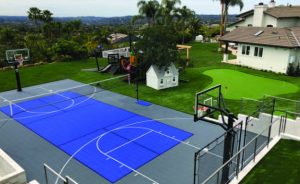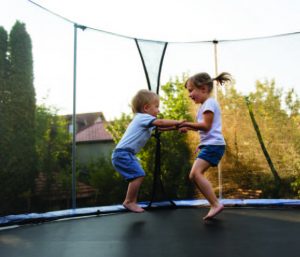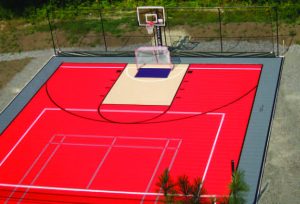The backyard sports court has joined a growing list of value-added home improvements.
Almost every person with older siblings remembers the first time they beat them in a game of backyard basketball. In those moments, the trees become spotlights, the chattering birds are transformed into thousands of roaring fans, and your Dorito-stained tee-shirt morphs into the jersey of your favorite sports team. Your backyard is no longer a backyard. It’s a colosseum of greatness and you are the superstar gladiator. What better way to gift your children that shot at glory than to build a sports facility right there in your backyard? It serves as a haven for family bonding, youthful development and boundless joy—with the added advantage that you control important elements of security and supervision. It’s also a great way to unglue your children’s faces from their screens and get them moving outside.

TD Sports West, Inc.
The traditional backboard-in-the-driveway set-up is still a popular choice, but you know kids these days. It may take something a little cooler (and pricier) to grab their attention and secure their buy-in. There is also another consideration: You may want to use it, too. So, depending on your budget, the size of your property and the interests of you and your children, everything is on the table, from batting cages and field hockey goals to basketball and tennis courts. Fortunately, you may not have to pick one and live with it forever. There is something called a “combo court,” which enables you to play up to 15 different sports using different equipment and markings. For instance, the same physical space can accommodate tennis, basketball, pickleball, badminton, volleyball, tetherball and handball.
Most people start with a single sport in mind and either go to their local sporting goods dealer for suggestions on builders, talk to a friend or neighbor who has installed a good-looking court, or poke around the Internet for ideas. All three have their pluses and minuses, but regardless of the path you choose, it’s a good strategy to begin with a checklist because this is an investment that, ideally, you’re only going to make once.

www.istockphoto.com
The Rule of 9
I checked in with TD Sports West, the go-to supplier of the Sport Court, a patented modular game court that is popular in the western United States. Marty Levy, the owner, has been at this awhile and helped me come up with the following decision-matrix “to-do” list:
1 Think about the sports your family plays. Take into account the age of your children, what they’re currently into, what they might be into in the future, and what athletic endeavors you yourself enjoy.
2 Think about how much space you have, and what percentage of that space you’re willing to devote to this project. Modular surfaces come in all different shapes and sizes. However, at the minimum, you’re looking at a 25’ x 30’ space for a usable basketball halfcourt. A tennis court-sized surface needs to be at least 60’ x 120’.
3 Check to see if your town requires you to get a permit to build the court you want. Be aware that most municipalities will not allow you to build a court in close proximity to any wetlands or over a septic system.
4 Take note of large trees on your property. Over time, their roots could damage the surface.
5 Consider where access to the construction site is likely to be. You may have to remove a fence or wall, sacrifice some landscaping, and vacate your driveway when the trucks and heavy equipment show up.
6 Pick the appropriate surface. Options include concrete, asphalt, synthetic turf, tile and modular surfaces. More on this later.
7 When it comes to equipment, triple-check to see that you’re dealing with a high-quality, reputable manufacturer. If something seems like it’s too good of a deal, it probably it.
8 Check to see if the surface you choose comes with a warranty (many do). Read that warranty carefully and ask questions in case any future troubles arise.
9 Even if you are a skilled do-it-yourselfer, don’t do it yourself. Hire a professional who’s done it before.
Before signing on the dotted line, there are some other considerations you need to be aware of. Local zoning ordinances are your responsibility to understand, not your builder’s—no matter what your builder says. If you need to submit plans to the town or adhere to rules governing “accessory structures” (such as ramps or fences), by all means do so. Also be aware that your town may have regulations about the height, purpose, or proximity to neighboring properties even when your neighbors have given you a friendly thumbs-up.
Finally, give your insurance agent a call to see if your new addition will trigger any policy complications. Most backyard sports complexes don’t pose any issues, save for trampolines and skateboarding ramps, due to their high injury liability, but also check if you are covered should a neighborhood kid take a spill and end up in the ER.

www.istockphoto.com
Cost vs. Benefit
If this is sounding more complicated than it should, well, what isn’t these days? Is it worth the expense and hassle? I spoke with Marty—not the TD Sports guy, a different Marty—a father of two I remembered from my old neighborhood. Back in 2003, he built a nice basketball halfcourt for his children. He has never regretted that decision: “I would just say that the best part of the court was my kids thinking that they were playing at the Staples Center and dunking the ball like Kobe Bryant. I think those are priceless things for families to cherish and a motivation for people to build something like that. When you’ve got a family, do you want to create the place where all the kids hang out? I definitely wanted to do that. Things like having a Slurpee machine, and always having snacks and water, and being the place that was comfortable for all the kids was really important to me.”
Now to the $64,000 question: expense. First of all, can a backyard sports court actually cost $64,000? Oh, yes. Should is cost that much? Let’s take a look at some common backyard sports options and their costs.
Where basketball courts are concerned, the first decision to make is whether you want a full court or a halfcourt. A full-length, NBA-sized basketball court is 50’ x 94’ (4,700 square feet). One step smaller is a high-school basketball court, which is 50’ x 86’ (4,300 square feet). You can go with something smaller, of course, with hoops on each end. If you’re like most people and you just don’t have the space for end-to-end action, be aware that halfcourts come in all different shapes and sizes. Halfcourts range in size from the 25’ x 30’ for a “mini” halfcourt (750 square feet), to a “regulation” halfcourt, which is 50’ x 45’ (2,250 square feet).

www.istockphoto.com
The price of an outdoor basketball court depends on the surface you select. In general, your options are cement, asphalt, tile or a modular surface. Every cost has gone up during the pandemic, but assuming things get back to normal during the upcoming building season, a concrete court will cost you between $1.25 to $1.75 per square foot for the concrete itself, and $2.50 to $8 per square foot for its installation. Let me do the math for you: A full-sized concrete court will cost you between $15,000 -$45,000, while the larger halfcourt will cost you $8,500 to $22,000. A mini halfcourt will land somewhere in the $5,000 to $10,000 range. Asphalt costs around $4 per square foot, so you’re paying around $19,000 for a full-sized court, $17,000 for a high school full court, $9,000 for the large halfcourt, and $3,000 for an asphalt mini court. Keep in mind that while asphalt may be cheaper, it’s more likely to cause injuries due to its naturally uneven and abrasive surface. My knees are still marked up from my blacktop basketball days. Snap-together tile surfaces cost anywhere from $3.50 to $4.50 a foot, so their prices are pretty similar to asphalt. What’s nice is that they often come pre-painted and they’re relatively simple to install. Lastly, modular courts are made of an advanced interlocking polymer web providing a cushioned surface that is both easy on the body and easy to install. The material is more expensive upfront but cheaper to work with. A lighting system to keep the games going after dark can be installed for under $2,000.
Tennis courts are easier to price out because they tend to be the same size. A tennis court’s dimensions, as previously noted, are 60’ x 120’ and you can’t really skimp on that number. The key decision is your surface option. Clay courts are typically the cheapest surface but require the most maintenance. You’re looking at a price range from $30,000 to $80,000 for a clay court depending on the type of product you use and the difficulty of site preparation. Clay courts are easier on the knees and the budget, but require up to $2,000 a year in basic maintenance and have to be “closed” for the winter and “opened” for the spring by a professional service. Most people in New Jersey opt for a hard court, which involves a concrete base and an acrylic surface. This type of court will cost you $60,000 to $120,000 but requires minimal maintenance. The only foreseeable upkeep is repainting worn court markings and occasional re-surfacing of the acrylic if any cracks appear, which can get expensive if you are especially picky about the playability of your court.

TD Sports West, Inc.
There are still some people crazy enough to install grass courts, which range from $50,000 to $150,000 but require a fat wallet and a skilled greenskeeper to maintain. The folks who are in this business are a dying breed but they are still around. The next best thing to grass, synthetic turf courts, run $75,000 to $100,000 to install, and are obviously much easier to maintain. However, they don’t offer anything like the feel of playing on a real grass court. Regardless of your surface selection, you will need fencing for your tennis court, which typically adds between $5,000 and $15,000. For lighting, if your neighbors and your town allow it, you can double that cost. Finally, set aside at least $3,000 to cover the cost of leveling your property and another $4,000 for creating some kind of drainage system, regardless of the court you plan to install.
Combo Courts
The combo court is a relatively new player in the sports-court game and it makes me wonder why these things haven’t been around longer. Time is an unstoppable force and, one day, your little ones will have grown up and flown out of your home nest. Existential crises aside, you are now faced with a colossal concern: What am I going to do with my outdoor sports court now that the kids are out of the house? The most obvious answer is to use the court yourself.
Which is why more and more homeowners are looking at combo courts, which, as mentioned earlier, can accommodate several different sports as tastes and interests and ages change. And so what if your above-the-rim days may be over, or your knees can’t tolerate more than the occasional game of tennis? Think of the other ways you can put a large, flat flexible space to work. Backyard parties and events—perhaps for a local school or favorite charity—are a great reason to keep them in play. My old neighbor, Marty, is already thinking about repurposing his basketball court (and Slurpee machine) in ways that have zero to do with basketball.
And why not? The time, money and energy you put into creating an awesome backyard sports court does not have to be about short-term payback. With thoughtful planning, it can pay dividends for the rest of your life.





